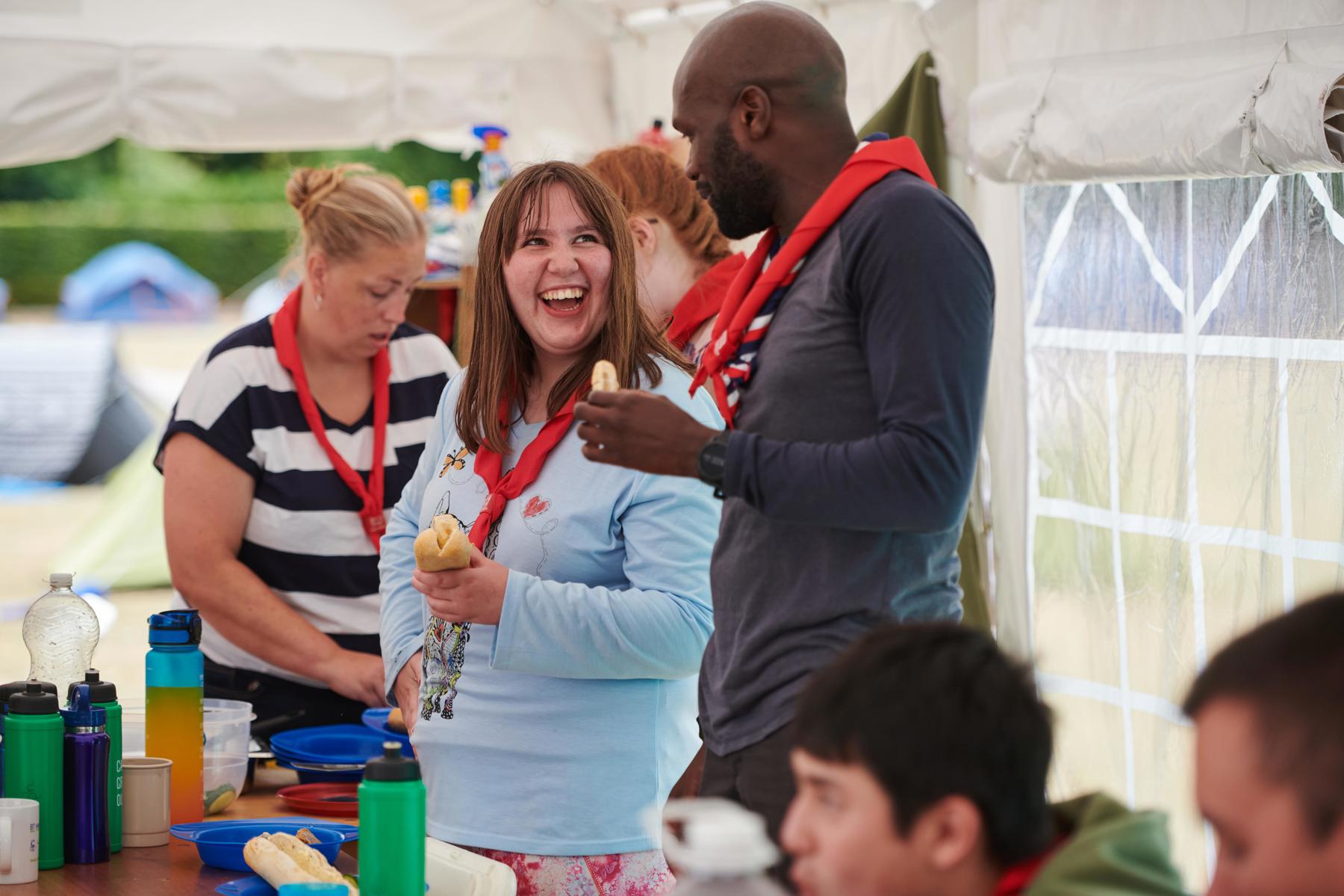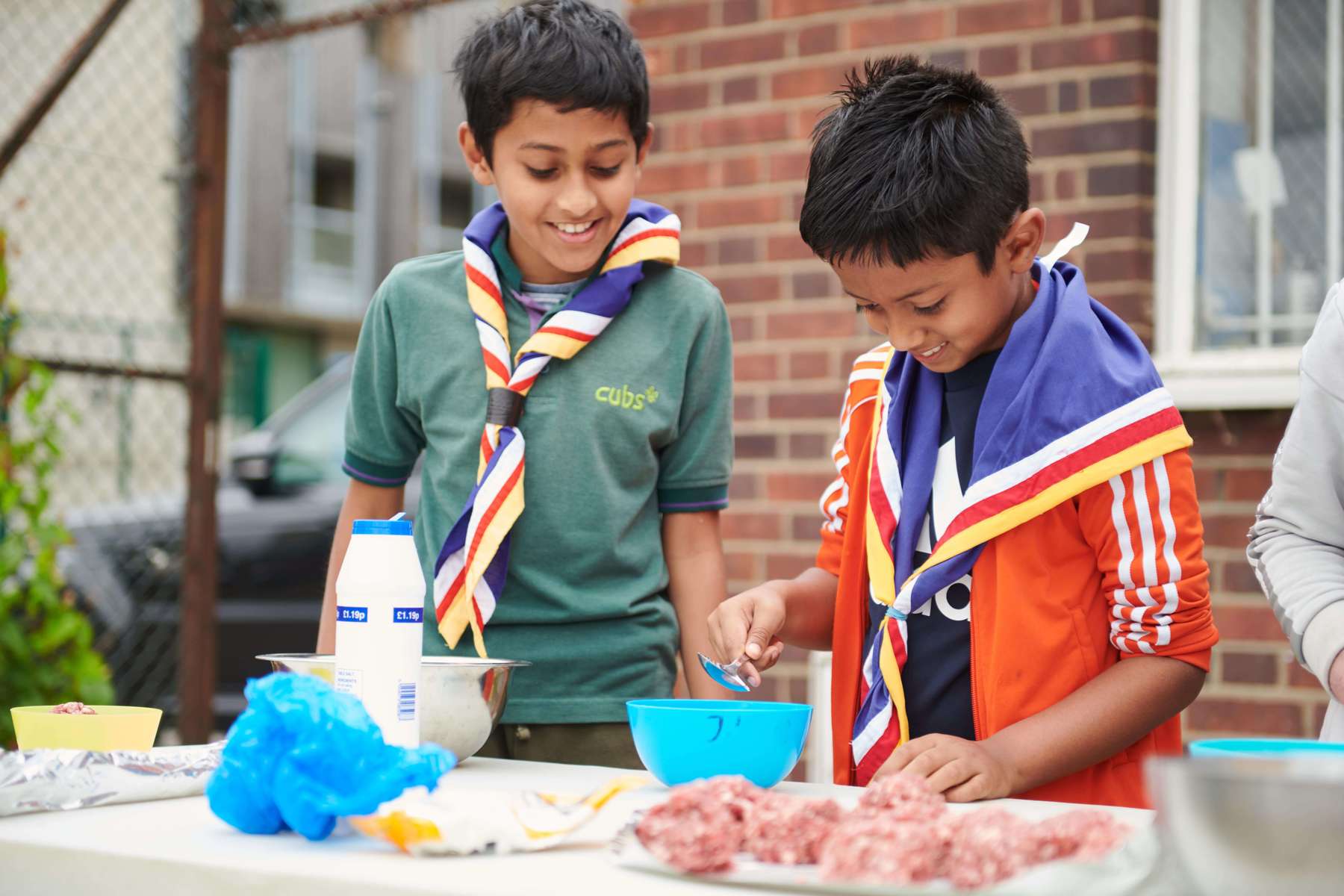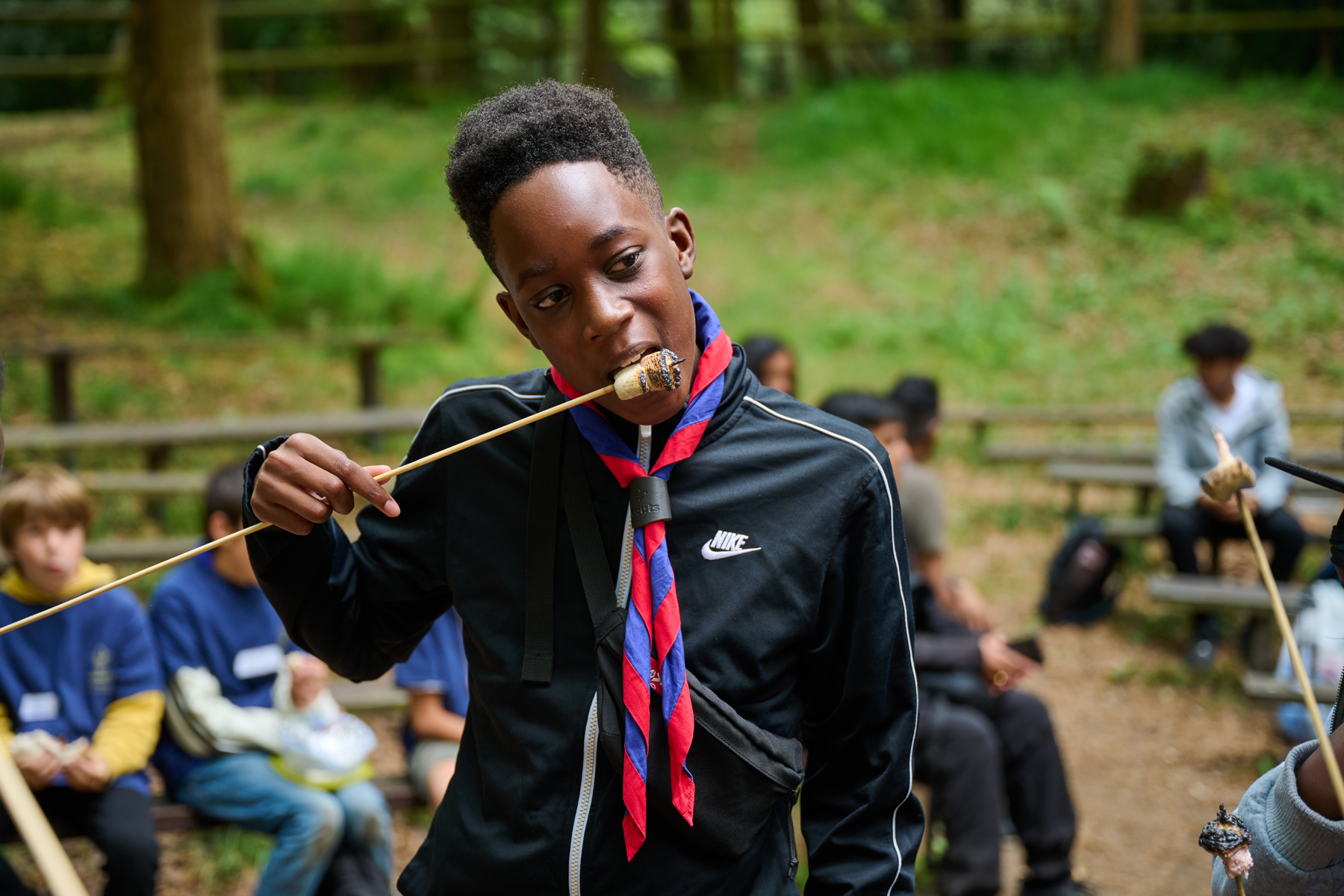Camp menu guidance
Encouraging camp safety and healthy eating, here’s some guidance on how to plan an enjoyable menu for everyone.
Menu planning is an essential aspect of any successful Scouts adventure, as it directly impacts people's energy levels.
When designing a menu for Scouts, it's crucial to strike a balance between energising and comforting foods. Involving Scouts in the menu planning process can empower them to make choices that align with their preferences, further enhancing their enjoyment.
It's also important to consider dietary requirements and allergies within the group to accommodate everyone's needs, ensuring that every Scout can enjoy their meals safely and comfortably.
The Nights Away book has some great advice on catering on residential events.

15 top tips for preparing a great menu
As you're menu planning, remember to include adults and any day visitors. You may want to add in a few extra meals into your plan, just in case numbers change. The menu should be balanced and contain appropriate amounts of protein, fat, fibre and carbohydrate.
It’s best to match your menu and food choices to the age group.
Young people, especially in younger sections, will likely feel more comfortable eating things they’re used to, such as at home, at school or at college.
If you’re running a multi-section camp, it’s important to offer something that’ll appeal to all age ranges.
How many meal options will be provided? Will there be a range of different things to choose from to meet all needs?
If there are options to choose from, will you ask people what they’d prefer before you go? This can help you to work out how many meals you’ll need of each menu option.
If working with Squirrels, you should take a look at meal safety advice for four and five year olds to prevent choking. Younger age groups may need their food to be prepared or cut differently to help them eat safely.
Healthy snacks can help keep people energised throughout the day.
It’s advisable to have fruit and water or low sugar content squash available all day to allow young people to supplement their meals in a healthy way.
You may want some special treat snacks, such as marshmallows for toasting or on top of hot chocolates.
Some people may also need to carry and have snacks with them for medical conditions.
You’ll need to plan what snacks you want to provide, if any, as well as how these will be stored and transported.
Will you allow people to buy or bring snacks too? Will food be allowed in rooms or tents? How will the consumption of snacks from home be monitored?
Any snacks, including those brought with attendees, will also need to be inclusive of allergies, food intolerances and dietary requirements.
Will you want young people to have access to any on-site shops with their spending money?
Most camp sites operate have on site shops, including snacks, sweets and chocolate. Always check the opening times and make sure people don’t fill up on sweets just before eating meals.
If you’re at a location without an on-site shop, you may choose to provide a small tuck shop.
It's generally best to keep to sweets in packets, choosing items that won’t melt or go off quickly.
Remember to try to limit how much each person can have and the times at which they can access it.
As you create your menu, take into account the environment you'll be in and the facilities you’ll have access to.
Will you be self-catered? Or is the site catering for you?
The time of year will also influence your decision, for example, in summer a light lunch of sandwiches might be preferable, whereas in winter you would probably want all meals to be hot.
What indoor or kitchen access will you have, or will you always be outdoors? If you plan to cook outdoors, plan to have a backup.
If you’ve only got a barbecue or are relying on a campfire, if it rains your plans will be scuppered. Make sure you have an alternative method of cooking food
Some other things to think about are drinking water access and how you will maintain good hygiene, such as regular hand-washing.
Regarding lunch and dinner, your programme will dictate whether one or both meals are cooked. If there is only one hour allowed for lunch, unless you are centrally catering, it's likely there’ll not be time to prepare, cook and clear away a hot meal.
You’ll need to build an appropriate amount of time into your programme for the preparation of food, too.
If you need to get a cooking fire started, you will need to allow a longer time than if you were cooking on a gas stove.
Washing up will also take longer if cooking on a fire as the outside of the pans will be a lot dirtier.
If you’re self catering, you should allow at least two hours for the meal from start to finish. Young people are not always used to catering for themselves and will need organising and supervision to make efficient use of time and teamwork.
Centrally-catered events will allow you to have more activity time, but will not give the young people experience in how to cater for themselves.
One option may be to have food on the go, such as packed lunches, or grab-and-go food that people can take with them for breakfast.
If the young people are catering for themselves, you will need to consider the following:
- have they cooked before
- what type of food have they cooked
- will they be cooking on barbecues, in a kitchen, on open fires or using gas stoves
- how much cooking equipment will be needed
- how long will preparation, cooking and washing up take
This might help you to plan in some cooking and kitchen skills sessions before camp.
Centrally-catered events will allow you to have more activity time, but will not give the young people experience in how to cater for themselves.
It may be possible on camps to combine the two approaches with a mixture of small group cooking and central cooking. For example, under the guidance of the cook, a duty team could assist in meal preparation on a rota basis.
On camps, which are mainly centrally catered, you could arrange for one or two meals where the young people can have a go at backwoods cooking on fires without pans.
Try to avoid high-risk foods, such as pre-cooked high protein. You should consider safe options to hazardous foodstuffs.
For example, will tinned corned beef suffice in place of raw mince?
After deciding on what to cook, when to cook and how to cook it, put together a shopping list that's suitable for all participants.
Think about when the food will be bought and how the food will be chosen, handled, bagged, delivered, transported and stored.
If someone needs to use a certain type of food, such as gluten free biscuits, it’s often easier to just buy these for the whole group if you're able to, reducing any risks of cross-contamination.
The Nights Away book has some great advice on quantities needed for your camp.
The timing of your food purchasing will depend on how long you will be away, the availability of local stores, transport and storage facilities.
For a weekend event it may be best to purchase your provisions shortly before you leave and take them with you.
If you don’t have the cool box/fridge capacity, or are on a longer event, you’ll have to purchase some of your supplies whilst on camp from local stores.
For long events, find out if you’re able to pre-order online from the main supermarkets that offer a delivery service in the area.
Alternatively, you can do the shopping as and when required on the event.
Remember to take into account the transit time of food from the point of purchase, or removal from temperature-controlled conditions, to the point of preparation and consumption.
This is especially important on expeditions, such as a Duke of Edinburgh (DofE) residential events, when food items are often carried in rucksacks for several hours.
Remember to check for food-related medical conditions, food intolerances and allergies, eating problems or dietary requirements and adjust the menu or snacks provided as appropriate.
This may include ensuring no cross-contamination during food storage, preparation, cooking and serving.
Always speak to the person and their parent or carer to find out what's best, and always plan and follow good food hygiene and safety practices.
You’ll need to think about the practicalities as you plan.
Consider and plan for:
- reducing outdoor cooking or kitchen hazards
- following good safety and hygiene practices
- any changing weather
- your environment
- having good hand-washing facilities
- access to cleaning equipment
- food storage and preparation
- signage
- what cooking equipment you need
- how you’ll be cooking
- where you’ll be eating
- how you’ll be serving food
- keeping carbon monoxide and fire safe
- using, disposing of or storing leftover food
Take a look at our guidance, including Food Safety guidance, Carbon Monoxide (CO) guidance, catering and stove guidance, cooking in winter and our cooking example risk assessments.
Be conscious about who may be fasting when providing snacks, eating and drinking.
Here are some ways you can support everyone to feel included in Scouts while fasting and include everyone in Scout events.
An eating disorder is a mental health condition where you use the control of food to cope with feelings and other situations.
People with eating disorders may need extra support when food or talking about food is involved, such as on camp or Nights Away.
Discover our guidance on eating disorders.

Staying safe when cooking
All activities must be safely managed. Use the safety checklist to help you plan and risk assess your activity.
Carry out a thorough risk assessment and make sure all young people and adults involved in the activity know how to take part safely.
Take a look at our Scouts guidance, including Food Safety guidance, Carbon Monoxide (CO) guidance, and catering and stove guidance.
Dietary requirements, food allergies and intolerances
Remember to check for food intolerances and allergies, eating problems or dietary requirements and adjust the recipe as appropriate. This may include ensuring no cross-contamination during food storage, preparation, cooking and serving.
Always speak to the person and their parent or carer to find out what's best.
Check if there are any items of food (or packaging) that people can’t touch or be near to. You should also check if there are items that people might not be comfortable using in the activity.
For some dietary requirements and allergies, you may need to use separate preparation and serving zones. You may need to use separate cooking utensils and equipment, such as separate chopping boards, knives, pans and toasters.
You should always plan and follow good food hygiene and safety practices.
For severe allergies, you may need to tell people not bring or pack certain items, such as nuts. You should tell people before the event and have signs up to remind everyone during the event.
Remember, some dietary requirements and allergies may also apply to wider activities, such as allergies to peanut butter for making some bird feeders.

Scout Activity Badges and activities
There are lots of badges to be earned when cooking and meal planning. Discover all our Scout badges related to cooking.
You can also earn Challenge Awards, including:
Take a look at our campfire recipes for some inspiration.
Menu planning for Squirrels
Take a look at meal safety advice for four and five year olds to prevent choking.
Food safety advice for four and five year olds